The Five Types of Daily Puppy Appointments
What is a “Puppy Appointment?”
A Puppy Appointment is a chunk of time where you set your puppy up to behave a certain way when in a specific situation . With consistency, that way to behave becomes an ingrained habit.
For example, you’ve learned that how you behave at the movies is different than you would behave at a party. You don’t really have to think about it – this knowledge is entrenched.
On this page I’ve described what I consider to be “Foundation” appointments – five different situations or contexts that will teach your puppy useful skills for adulthood and reduce common puppy problems, while keeping you sane. The five foundation Puppy Appointment types are : 1. Potty Breaks, 2. Training/Playtime, 3. Rest Time, 4. Self-Amusement, and 5. Socialization.
For each Appointment Type I’ve listed the tools you’ll need and photos/videos to help you along.
Understand the Five Appointment Types!
You will need to implement every type to use the Puppy 911 method successfully.1. Potty Break
Tools needed: Martingale collar, Lightweight Leash

Put the collar and lightweight leash on the puppy. Immediately take the puppy (carry if you think the puppy can’t “hold it” or is resistant to the leash) to a designated “potty area”.
Hold the leash slack and allow the puppy to explore the area. Keep the puppy in the area until he “finishes his business” – do not engage in play. This is so the puppy learns that there is a difference between pee time and play time. When you believe the puppy is empty the leash can come off (if in yard) and they are free to run around and play!
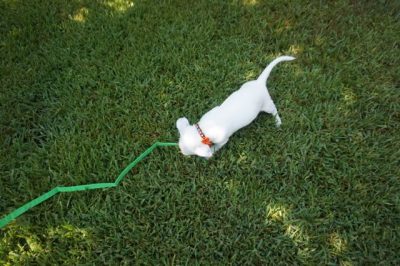
If your puppy has gotten accustomed to running freely in the yard, he might struggle with the leash, especially if he hasn’t gotten used to wearing one. For that reason, I recommend the first time you use the leash you are certain that the puppy has to pee – first time out in the morning is usually a good bet.
If they do struggle with the leash (it might look like a mini-temper tantrum), just pick them up and put them back down in the area you want them to potty in. If they continue to struggle, it’s possible they don’t need to potty. Try again when you are certain they do!
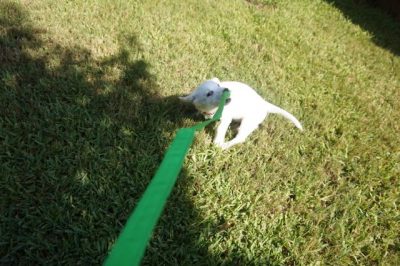
How often should I give my puppy a Potty Break?
Though every puppy is different, a safe rule of thumb is every 30 minutes when your puppy is awake and active. Your puppy might be able to go longer or not that long though. If you are even a little worried that the puppy might have an accident, then you waited too long for the next Potty Break.
They should also be given a Potty Break first thing in the morning, last thing in the evening, and anytime they’ve just woken from a nap.
30 minutes? But my puppy goes all night without peeing!
The 30 minute rule only applies to puppies that are awake and active. During rest, they should be able to go much longer.
How often will my puppy poop?
Every puppy is different! You will need to learn your puppy’s poop patterns. A good bet is around 20-30 mins after a meal. How many times a day does the puppy poop? Around what times? It might be a good idea to keep a “log” (pardon the pun).
Look, I’m busy and I have a job and there is no way I can get my puppy out every 30 minutes!
That’s ok! You will be using “Rest Time” and “Self-Amusement” appointments to make potty training meet your lifestyle needs.
How long should each Potty Break be?
Potty Breaks should be no longer than 10 minutes and can end as soon as you think the puppy has fully eliminated. When you think they are finished, they should be rewarded with a few minutes of playing (off-leash if in yard). It’s perfectly ok for them to pee/poop more while outdoors.
What if my puppy doesn’t potty in under 10 minutes?
You have a few options here.
Option A: Take the leash off and let the puppy run around freely. How soon after you take off the leash does she pee? If it takes a few minutes, then she probably just didn’t need to go that badly. If it’s nearly immediately, then she might be too distracted by the leash. Next time, you might just allow her to drag the leash around freely so she gets accustomed to it (she might pee on the leash though!).
Option B: Put in “Rest Time”. After anywhere between 10 and 30 minutes, take out for another “Potty Break” attempt. Repeat until she pees.
Option C: Put in “Self-Amusement” area with pee pads. This won’t help the puppy learn to potty outside but it will at least prevent her from deciding that your rug is her bathroom.
Should I give my puppy a treat when she potties outside?
Some trainers recommend giving a treat when they pee/poop outside. Personally, I see that often backfire because some puppies will stop eliminating before they are actually finished, in anticipation of the treat.
Can’t I just teach my puppy to ring a bell to tell me when they need to go potty?
Down the road, sure, but you need them to be completely clear that outside is the place for pottying first.
What should I do if I catch my puppy peeing or pooping in the house?
Do not scold the puppy! Just gently interrupt the peeing/pooping, pick them up and get them to their proper bathroom area! Then scold yourself for being slack on the potty training. Then forgive yourself because we all mess up sometimes.
2. Training/Playtime
Tools Needed: High Quality Puppy Kibble, possibly Training Treats, Squeaky Toys
Training/Playtime appointments are when you will be actively interacting with the puppy. Instead of feeding your puppy’s meals in a bowl, use the kibble to teach basic self-control skills and tricks. You can also use treats and toys. Can be as short as 5 minutes. When indoors, training and play periods should be limited to a maximum of 30 minutes.
3. Rest Time
Tools Needed: Dog Crate, Twist n’ Treat or Classic Kong, Peanut Butter or Yogurt, High Quality Puppy Kibble, Training Treats (optional)
During Rest times put your puppy in a dog crate with a soft blanket and a well-stuffed Twist n’ Treat or Classic Kong. You may need to take additional steps to crate train the puppy. Rest Times should not be longer than 3-4 hours. If you need to leave your puppy for longer than 3-4 hours, it should be a Self Amusement appointment.
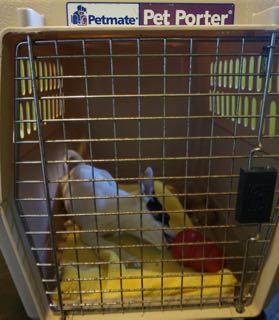
4. Self Amusement
Tools Needed: X-pen or Baby Gate, Twist n’ Treat or Classic Kong, Yogurt, High Quality Puppy Kibble, Pee Pads (if longer than 30min), Training Treats (optional), Dog Crate (optional)
During a Self-Amusement appointment, your puppy is free to do whatever she wants in safe, enclosed space where she can’t get herself into trouble. Puppies are not computers – you can’t just turn them off when you are done playing. Instead, you need to teach them how to keep themselves amused for when you can’t keep an eye on them. Put the puppy in a secure x-pen with some toys and a stuffed Twist n’ Treat or Classic Kong. Now they can play or rest without getting themselves into much trouble.
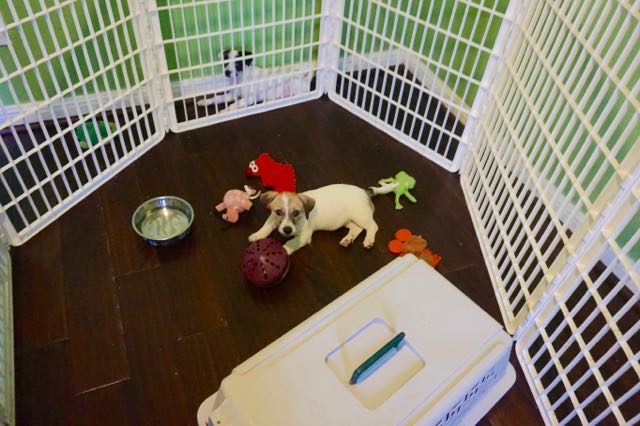
Typically, when puppies are awake/playing, they will need to pee at least every 30-45 min. They will also likely need to pee anytime they wake up from a nap. So if your puppy is going to be in the pen for more than 30-45 mins then you should place puppy pee pads in the corner for them to do their business (tip: tape them to the floor so the puppy doesn’t shred them!). Otherwise you will need to make sure that they get out to potty within that time frame or put them in their crate.
If you plan on leaving your puppy alone for longer than 3-4 hours, then an x-pen with pee pads in the corner is a necessity – it’s simply not fair to expect the puppy to be able to hold it, even in a crate (though they might be able to – every puppy is different).
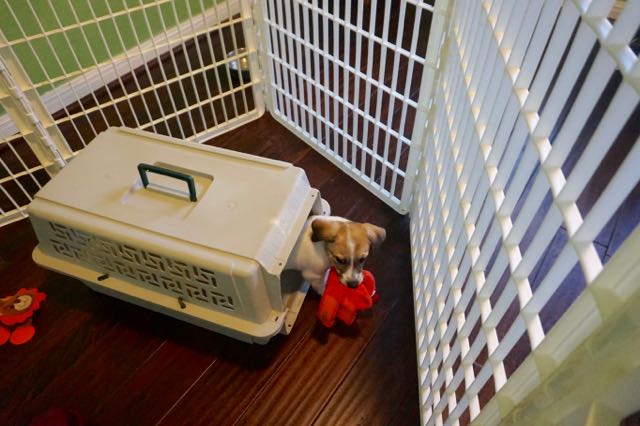
5. Socialization Outing
Tools Needed: Training Treats (high value), Lightweight leash and Martingale collar, pre-stuffed Twist n’ Treat or Classic Kong (optional – great to bring if you will be just hanging around somewhere like a patio)
Did you know that after 14 weeks of age, a puppy’s window for socialization begins to close?
Socializing is more than just meeting people and playing with other puppies. You also need to socialize your puppy to a wide range of environments and stimuli! Getting a puppy out and about can be tricky until they’ve had their vaccinations. But you need to do it! If your puppy is small enough, just carry him. If he’s too big to carry, then at least take him around in the car.
Do not overwhelm your puppy! Use extra high value treats (like tiny bits of cheese or hot dog) as a barometer to whether the environment is too stimulating for your puppy. A terrified puppy will usually ignore any food you try to give. Start with easy, quiet places. The first day maybe try front porch. Will your puppy take the cheese out there? Great! What about at the end of the driveway? Awesome. Maybe a quiet intersection the next day?
If the puppy is handling the easier environments well, then progressively move on to more difficult spots like a slightly busier intersection, a small pet store, a quiet park or restaurant patio during unpopular hours.
Then move on to even harder spots – busier pet stores, parks, patios, Home Depot, near a children’s playground.
You should also get your puppy accustomed to being physically handled in ways that might not be completely comfortable. For a few minutes a day, hold some food in one hand and put on your puppy’s nose. Let your puppy have a little bit of food at a time while you examine your puppy with your other hand look at the ears, eyes, teeth, gently pull the tail (like a child might), lift the paws, touch each toe and in between. Eventually, you’ll start touching the feet with nail clippers until that doesn’t bother the puppy. Even if your puppy does not object much now, when they are older that is likely to change unless you teach them to enjoy it. A few minutes a day now will save you lots of grief later!
In addition to the above, I highly recommend a well run puppy class. Look for a class with an instructor that is experienced and understands the importance of not just exposing your puppy to new things, but giving them positive experiences with these new things. Try to find a class with puppies of similar ages and sizes, bigger/older puppies can be intimidating to smaller/younger puppies – there is a big difference between a 3 month old and a 5 month old, and between a 5 lb pup and a 15 lb pup!
